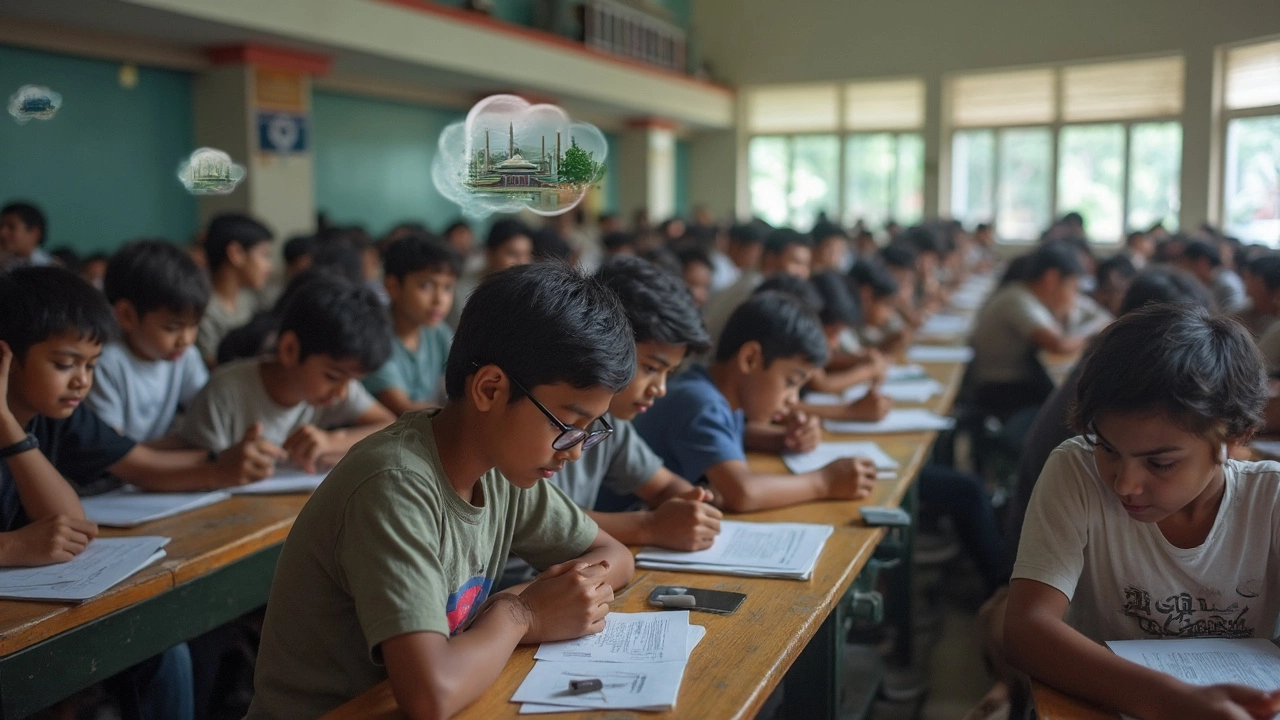Why do thousands of students chase IIT Bombay every year, knowing the odds are so wild? Honestly, it’s not just the shiny campus or impressive jobs—there’s a kind of myth around it. But if you’re thinking about aiming for this place, you need to know what you’re signing up for. Spoiler: the road isn’t pretty, and most don’t make it.
Here’s the deal: over a million students sign up for IIT JEE, and barely a sliver crack into any IIT. But IIT Bombay? That’s another level. In 2024, only about 1 out of every 100 who wrote JEE Advanced even landed any seat at IIT Bombay. Not the branch of their dreams—any seat. So if you’re picturing a fair fight, think again. This is Hunger Games for nerds.
But don’t freak out yet. There’s a reason some make it while others don’t, and it’s not just about being a born genius. Plenty of regular kids have pulled it off—by getting the right help, avoiding rookie mistakes, and staying smarter than their competition (and sometimes, their own nerves). Wanna know what really goes into this grind? Keep reading to see what matters, what doesn’t, and where most hopefuls slip up.
- Why IIT Bombay Keeps Its Doors So Tight
- How Low Is the Acceptance Rate, Really?
- What The Top Rankers Actually Do
- Mistakes That Crash Most Aspirations
- Is Coaching Truly Required?
- Handling Stress and Expectations
Why IIT Bombay Keeps Its Doors So Tight
It’s crazy how tough it is to grab a spot at IIT Bombay—even among all the IITs, this campus is the crown jewel. There’s a simple reason: almost everyone who dreams of becoming an engineer in India wants to be right here. You’re fighting for a seat against the best of the best in the country.
IIT Bombay has just about 1,200 undergraduate seats each year, yet over a million students take the JEE Main, and roughly 1.8 lakh qualify for JEE Advanced. In 2024, about 18,000 were eligible for a seat in any IIT, but only the top 60-80 All India Ranks would get Computer Science at IIT Bombay. People fight tooth and nail for every single seat, especially in the popular branches.
How come the bar is so high? Companies like Google, Microsoft, and Goldman Sachs knock straight on campus doors, offering crazy high salary packages. In December 2024, one student got a job at INR 3.7 crore per year. Even if you don’t land those sky-high deals, the average placement at IIT Bombay last year was around INR 25 lakh. That’s a game-changer for most families.
But it’s more than jobs—the prestige packs a punch too. Being an alumnus of IIT Bombay means your name carries serious weight anywhere, from US grad schools to Indian startups. So yeah, tons of students are scrambling for a brand that pretty much guarantees opportunities for life.
To protect its reputation, IIT Bombay can’t just let anyone walk in. Every year, they keep their entrance bar high to pick not just smart people, but folks who are madly committed and willing to work for it. No shortcuts work here. If you’re aiming for IIT Bombay, you’re going to fight for your place. That’s exactly how they want it.
How Low Is the Acceptance Rate, Really?
People toss around the word “tough,” but the odds of getting into IIT Bombay are straight up savage. If you’re shooting for this, knowing the numbers helps you see what you’re really up against.
Let’s break it down with actual data. In 2024, about 1.4 million students registered for IIT JEE Main. Out of these, just over 200,000 qualified for the next round, JEE Advanced. Now, when it comes to IIT Bombay seats? Here’s what you’re looking at:
| Year | JEE Advanced Candidates | IIT Bombay Seats | Acceptance Rate (%) |
|---|---|---|---|
| 2024 | 186,584 | 1,360 | 0.73 |
| 2023 | 180,226 | 1,360 | 0.75 |
| 2022 | 155,538 | 1,366 | 0.88 |
So, out of all the kids burning the midnight oil, less than 1% get in. Ask anyone who’s tried, and they’ll tell you—just getting to the JEE Advanced stage is an achievement, but IIT Bombay is the unicorn.
“The competition is so fierce that even scoring a rank in the top 500 doesn’t guarantee you your dream branch at IIT Bombay. You need to be consistently ahead in every subject, from day one.” — Vinay Kumar, Senior Faculty at Allen Career Institute
It’s not just overall numbers. Cut-offs for popular streams like Computer Science are even crazier. In 2024, you needed to be in the top 66 ranks for CSE at IIT Bombay. So, if you’re going for something specific, it’s actually harder than it looks on paper.
- Acceptance rate for top branches is way lower than the overall rate.
- Reservation policies play a role, but General category seats see the harshest crunch.
- Getting selected means you’ve beaten more than 99 others out of every 100 who tried.
Anyone telling you IIT Bombay admissions are just about “working hard” is selling a shortcut that doesn’t exist. The bar is high, and the numbers prove it. But knowing that up front isn’t meant to crush your hope—just helps you prep smarter so you don’t waste time on myths and hype.
What The Top Rankers Actually Do
Ever wonder how those folks who grab single or double-digit AIRs at IIT Bombay make it happen? There’s no secret IQ level. It’s more about habits, routine, and focus—plus dodging common traps that trip up most students.
The best of the batch start their prep early, usually from class 11 or even late 10th standard. They keep up with the syllabus, hardly ever letting concepts pile up. A pattern stands out: they make their own notes. Not just doodles or scribbles, but real, crisp notes from NCERT and tough reference books like H.C. Verma for physics or MS Chauhan for chemistry.
"I always made short notes and stuck them to my wall—the key formulas, reactions, and those weird exceptions that show up every year," says Anant Kumar, AIR 5 (JEE Advanced 2023).
Here’s what else the toppers do—
- Practice, daily: They solve JEE Advanced-level questions every single day, not skipping weekends. And they aren’t just solving to finish—they review every silly mistake, so it doesn’t happen twice.
- Mock tests: Toppers take at least 30-40 full-length test series before the big exam. Each test is treated like the real thing: three hours, no breaks, phone in another room.
- Analysis, not panic: A high scorer spends almost as much time reviewing wrong answers as they do taking new tests. The focus is always on ‘why’ an error happened, not just marking it wrong.
- Limited resources: Here’s a surprise—most toppers don’t touch every book out there. They swear by coaching material, previous years’ JEE papers, and standard reference books. Jumping between ten books isn’t their style.
- Healthy routine: Sleep is non-negotiable. At least six to seven hours, even during crunch time. They squeeze in some gym or a daily walk to keep their head clear.
The stuff they avoid is just as important. No endless social media scrolling during breaks, no last-minute cramming before tests, and no getting stuck on one impossible problem for hours. It’s not about being a robot, but about consistently making smart choices every single day.
Bottom line: Toppers are regular students who play it smart, stick to the plan, and fix their weak spots before they become big problems.

Mistakes That Crash Most Aspirations
Most students aiming for IIT Bombay fall into the same traps, no matter how bright they are. These mistakes aren’t mysterious—they come up almost every year, and toppers will tell you, dodging them is half the game.
- Rote learning instead of understanding: Mugging up formulas might work for board exams, but JEE Advanced is famous for twisting basic concepts in ways you haven’t seen before. You can’t guess your way through these questions.
- Ignoring weak subjects: Nearly every candidate has a love-hate relationship with at least one subject, and most choose to run from their weakest. Big mistake! The cut-offs in JEE Advanced are subject-wise. If you tank Physics or Chemistry, you’re out, even if you’re a Math wizard.
- Overloading with study material: There’s a myth that the more books you buy, the smarter you’ll get. In reality, trying to finish every popular book leads to burnout and confusion. Sticking to standard material (like NCERT and the ones experts recommend) works better.
- Ignoring mock tests and analysis: Stats show successful JEE candidates take at least 15-20 full-length mocks. Just attempting them isn’t enough—you’ve got to analyze every test, figure out silly mistakes, and actually fix them.
- Poor time management: A lot of students burn endless hours on easy chapters they enjoy. Meanwhile, tricky but important topics get ignored until it's too late. This warps your preparation and kills rank chances.
- Underestimating revision: Revision isn’t just going over notes the week before the exam. It means revisiting concepts, formulas, and solving new questions repeatedly across months.
- Burnout and health: Pulling all-nighters and skipping meals might sound hardcore, but it leads to mental fatigue and silly errors in the exam. That’s not sacrifice—it’s self-sabotage.
Here's a snapshot from 2024 showing just how punishing these mistakes can be:
| Mistake | Percent of Aspirants Affected | Impact on Results |
|---|---|---|
| Ignoring weak subjects | 58% | Failed subject cut-off |
| No mock test analysis | 45% | Poor accuracy, dropped ranks |
| Too many books | 35% | Confusion, burnout |
| Lack of regular revision | 51% | Forgotten concepts in exam |
If you want to get close to IIT Bombay, learn from these numbers. Don’t get caught up doing what everyone else is doing—especially if it’s the wrong thing.
Is Coaching Truly Required?
The big debate: can you get into IIT Bombay without joining a coaching center? Let’s cut through the hype. Look at the top 500 rankers every year—almost all went to some coaching, whether it’s Allen, FIITJEE, or Resonance. That’s not a coincidence. These institutes have cracked the art of pushing students just enough and drilling the right exam hacks into them.
But it’s not impossible to clear JEE without coaching. Some have gone solo and made it—usually super determined, self-motivated students with access to the right resources and a killer study plan. The thing is, most high-rankers say coaching made their journey more focused and less confusing, especially with the mind-boggling syllabus and unpredictable paper patterns.
If you’re thinking about skipping coaching, be honest with yourself. Are you disciplined enough to keep routines, analyze your weak spots, and hunt down practice material? Coaching isn’t magic, but the biggest brands know how to spot trends, predict ‘hot’ topics, and constantly pressure you to keep improving. That’s hard to duplicate alone.
| Mode of Preparation | Share in Top 500 (JEE Advanced 2024) |
|---|---|
| Full-time Coaching | ~85% |
| Online/Hybrid Coaching | ~10% |
| No Coaching/Self-study | ~5% |
The perks of coaching go beyond just notes and mock tests. Most centers offer regular competitive tests, doubt-clearing sessions, and group pressure that keeps you on your toes. On the downside, it’s busy, expensive, and sometimes burns kids out. That’s the honest truth.
- If your basics are weak in Physics or Math, coaching helps fix cracks before they become chasms.
- If you’re super organized and don’t panic easy, you might do well solo—just stick to daily, weekly, and monthly targets.
- For students in remote places, online coaching and YouTube channels (like Unacademy and Physics Wallah) are lifesavers. Many toppers now blend these with self-study.
So, is coaching required for IIT JEE? Not for everyone. But for most aspirants, it’s a solid advantage—especially if you want to fight for seats at places like IIT Bombay where just clearing the cutoff isn’t enough. It’s not the only way, but it’s the most proven one.
Handling Stress and Expectations
If you’re grinding for IIT Bombay, stress can hit harder than any mock test. It’s not just about long study hours; it’s the pressure from family, neighbors, and your own sky-high dreams. Here’s the real talk: burnout and anxiety are huge reasons students step back or underperform in JEE Advanced. According to a 2023 NTA report, nearly 28% of aspirants who dropped out before the big day blamed stress or mental health.
So, how do you handle it without losing your mind?
- IIT Bombay culture celebrates resilience, not just IQ. Everyone has meltdowns; toppers included. Nobody breezes through all those two-year marathons without hiccups.
- Break your prep into bite-sized goals. Instead of “I’ll finish the whole Physics book this week,” try “I’ll crack Mechanics by Thursday.” Weekly wins beat monthly panic attacks.
- Don’t ghost your friends or hobbies. Even an hour of cricket or Netflix can reset your brain better than all-nighters.
- Learn to say “No.” Not every parent WhatsApp group tip or friend’s study hack fits you. Filter out the noise early on.
- Discuss the bad days. If you bomb a test or just feel tired, talk. Teachers, parents, or even others prepping for the *entrance exam* get it more than you think.
Now, the numbers. Check out this quick overview of common stress sources for IIT JEE aspirants from a 2024 Allen poll:
| Source of Stress | % of Students Reporting |
|---|---|
| Self-Expectations | 45% |
| Parental Pressure | 35% |
| Fear of Missing Out | 10% |
| Peer Competition | 6% |
| Other Factors | 4% |
Finally, remember that no college is worth your mental health. Plenty of solid engineers came from places other than IIT Bombay. Stay practical, stay open, and if it gets too much—hit pause and ask for help. There’s strength in that, not shame.







